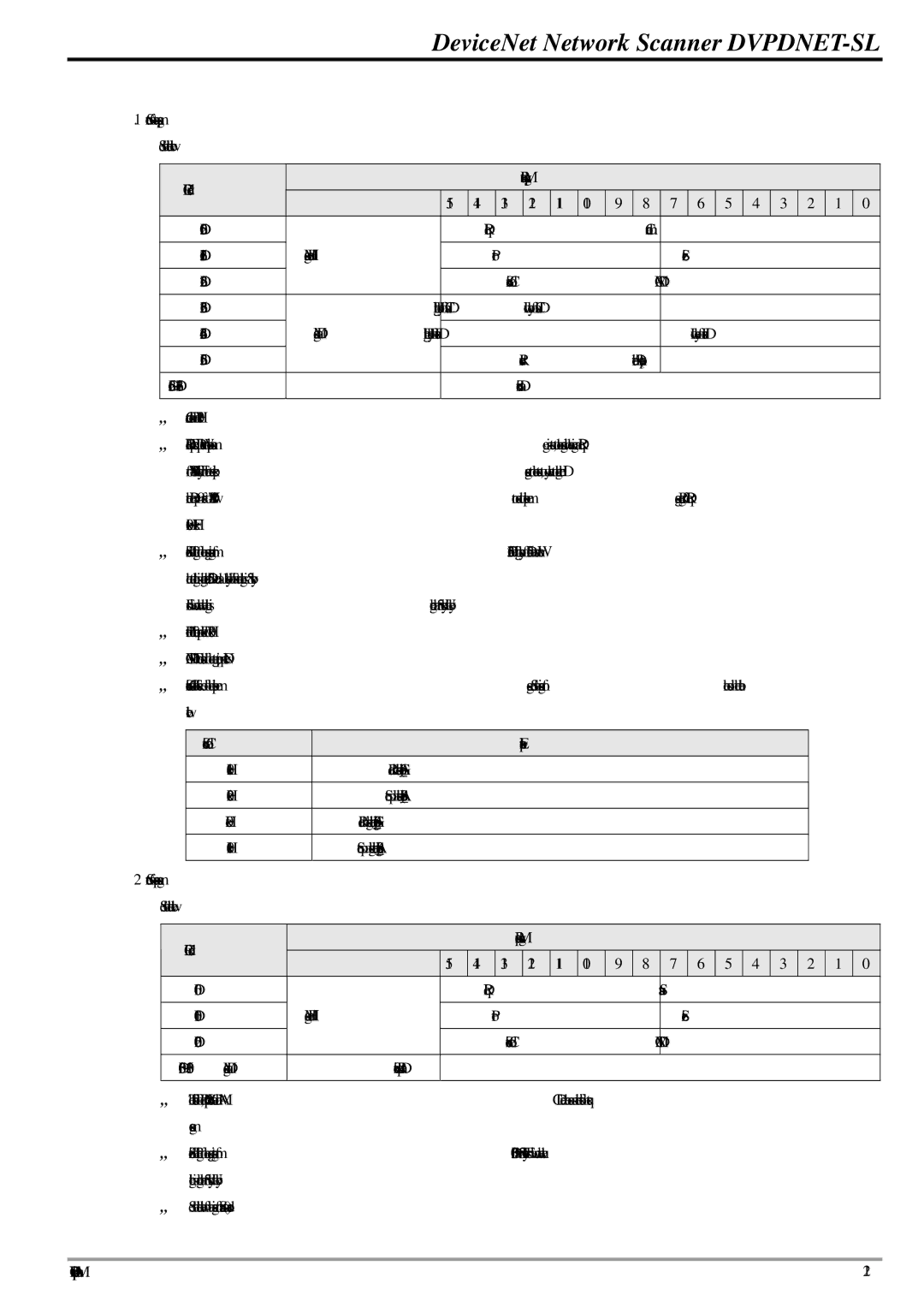
DeviceNet Network Scanner DVPDNET-SL
1.Structure of request message See the table below:
PLC device |
|
|
|
| Request Message |
|
|
|
|
|
|
|
|
| ||||
|
|
|
|
|
|
|
|
|
|
|
|
|
|
|
|
|
| |
| 15 | 14 | 13 | 12 | 11 | 10 | 9 | 8 | 7 | 6 | 5 |
| 4 | 3 | 2 | 1 | 0 | |
|
|
| ||||||||||||||||
D6250 |
|
|
|
| ReqID |
|
|
|
|
|
| Command |
|
| ||||
| Message Header |
|
|
|
|
|
|
|
|
|
|
|
|
|
|
| ||
D6251 |
|
|
| Port |
|
|
|
|
|
|
| Size |
|
|
| |||
D6252 |
|
|
| Service Code |
|
|
|
|
|
| MAC ID |
|
|
| ||||
|
|
|
|
|
|
|
| |||||||||||
D6253 |
|
| High byte of Class ID |
|
| Low byte of Class ID |
| |||||||||||
| Message Data |
|
|
|
|
|
| |||||||||||
D6254 |
| High byte of Instance ID |
|
| Low byte of Instance ID |
| ||||||||||||
|
|
|
|
|
|
|
|
|
|
| ||||||||
D6255 |
|
|
|
| Reserved |
|
|
| Attribute ID (optional) |
| ||||||||
|
|
|
|
|
|
|
|
|
|
|
|
|
|
|
|
| ||
D6256 ~ D6281 |
|
|
|
|
|
|
| Service Data |
|
|
|
|
|
|
| |||
|
|
|
|
|
|
|
|
|
|
|
|
|
|
|
|
|
|
|
Command: Fixed to “01Hex”.
ReqID: The request ID. Whenever an explicit message is sent out, the message will be given a ReqID for
00Hex ~ FFHex.
Size: The length of the message, starting from D6253. The high bytes of D6255 are reserved. When the data length is being calculated, D6255 is counted as 1 byte. The maximum data length is 58 bytes. Errors will occur when the length is longer than 58 bytes. Unit: byte.
Port: The communication port. Fixed to “00Hex".
MAC ID: The node address of the target equipment on DeviceNet.
Service Code: The service code of the explicit message. See the meanings of the codes in the table below:
Service Code | Explanation |
01Hex | Read all attributes (Get_Attribute_All) |
|
|
02Hex | Set up all attributes (Set_Attribute_All) |
|
|
0EHex | Read a single attribute (Get_Attribute_Single) |
|
|
10Hex | Set up a single attribute (Set_Attribute_Single) |
|
|
2.Structure of response message See the table below:
PLC device |
|
|
| Response Message |
|
|
|
|
|
|
|
| |||||
| 15 | 14 | 13 | 12 | 11 | 10 | 9 | 8 | 7 | 6 | 5 | 4 | 3 | 2 | 1 | 0 | |
|
| ||||||||||||||||
D6000 |
|
|
|
| ReqID |
|
|
|
|
|
| Status |
|
|
| ||
| Message Header |
|
|
|
|
|
|
|
|
|
|
|
|
|
| ||
D6001 |
|
|
| Port |
|
|
|
|
|
| Size |
|
|
| |||
|
|
|
|
|
|
|
|
|
|
|
|
|
| ||||
D6002 |
|
|
| Service Code |
|
|
|
|
| MAC ID |
|
|
| ||||
|
|
|
|
|
|
|
|
|
|
|
|
|
| ||||
D6003 ~ 6031 | Message Data |
|
|
|
|
| Service Response Data |
|
|
|
|
| |||||
|
|
|
|
|
|
|
|
|
|
|
|
|
|
|
|
|
|
The definitions of ReqID, Port, Service Code and MAC ID are the same as their definitions in request message.
Size: The length of the message, starting from D6003. Max. 58 bytes. Errors will occur when the
length is longer than 58 bytes. Unit: byte.
See the table below for the meanings of Status (status codes):
21 |
